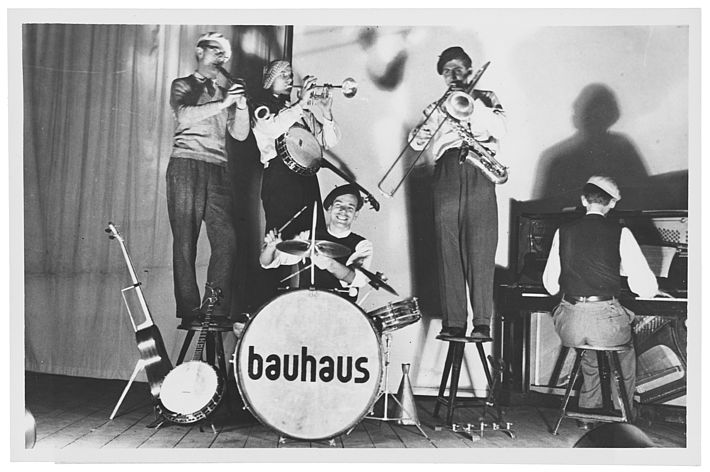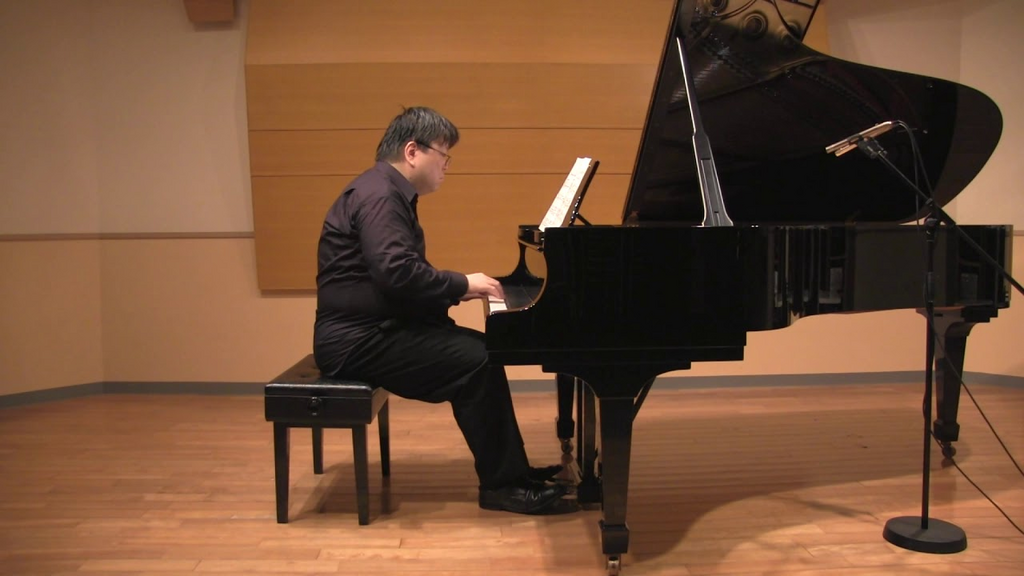“It’s striking! You have to hear us – you’ll be thinking of us.”
From the rhythmical noise of the Bauhaus band to the inspiring art of the fugue, to the performances of contemporary composers: Life at the Bauhaus was always accompanied by background music, though it was not even on the curriculum.

[Translate to English:] Text
Everyone was waiting for Weiniger. When Andor Weininger came onto the stage at the end of the happenings of the Bauhaus band, “noise” would be transformed to “deepest silence”. The students who were dancing wildly one minute to the “fantastic-rhythmical and piercing noise” of the partly home-made instruments, “sat on the floor in front of the stage” in clusters the next minute following Andor Weiniger’s performance. These were a mix of abstract songs and cabaret acts that were so touching that tears and the sweat from dancing would mingle, as the Bauhausler Xanti Schawinsky later described. The stirring Weiniger moments were, however, also important for another reason. Following his performances the actors of the Bauhaus stage often spontaneously “presented their theatre experiments in the making”. Oskar Schlemmer acted as a musical clown or Jost Schmidt performed a solo wrestling match. According to Schawinsky the Bauhaus band and Bauhaus stage were ”always closest” on these occasions.
When thinking of Bauhaus and music, the Bauhaus band immediately comes to mind. Retrospectively it seems all the more legendary, as there are no remaining recordings, but instead enthusiastic and at the same time somewhat helpless attempts to describe their playing. “They’re the best jazz band that I have ever heard ragging, musical all the way to their fingertips” Jan Kole Kokke rejoices in the Berliner Tageblatt in 1924. And on a promotional card the Bauhaus band itself summarises the effect they have as follows: “as you can see we survive all storms, we play our music, a funky and utterly gripping rhythm! It’s striking! You have to hear us – you’ll be thinking of us.”
The Bauhauslers had already founded an ensemble in Weimar. It quickly became famous, as it did not only perform at Bauhaus festivals, but also made guest appearances in other cities, promoting the school. They played classical instruments such as the trombone, banjo and clarinet, but also the so-called flexatone, a mix between a string and a percussion instrument, or even aided by tuning forks or colts. They played jazz classics, popular tunes, folk songs, and improvisations, but also pieces by Johann Sebastian Bach or Wolfgang Amadeus Mozart. And that’s why the Bauhaus band is still so important for today’s image of the Bauhaus: It is the most eminent proof of the famous Bauhaus exuberance, it did not care about the classical divide between serious music and popular music and demonstrated hands-on how the individual crafts at the Bauhaus coalesced.
The Bauhauslers depicted living and studying at the Bauhaus as seemingly having been determined by music and highlighted by the rhythm of the Bauhaus band. This easily let’s one forget that music was not even on the Bauhaus curriculum. One reason for this was that the Bauhaus was founded as successor institution of the Weimar Academy of Fine Arts and the College of Applied Arts. From the outset the Bauhaus was intended to offer training in artistic disciplines and crafts, as Marta Günter writes in her essay “Musikleben am Staatlichen Bauhaus in Weimar“ (“Musical life at the Weimar State Bauhaus”). While musical education was, taken over by the “State College of Music that emerged from the Orchestra School (…).”
All the same, music was very important at the Bauhaus. Apart from the performances of the Bauhaus band the Bauhaus masters organised musical evenings or concerts for friends and sympathisers with the aim of establishing the Bauhaus “as cultural location in the German Reich” and to associate “prominent personalities” with it. Up until 1921 mainly Baroque music was played at these rather representative events. Thus for example Prelude and Fugue in E flat major by Johann Sebastian Bach were to be played at a planned morning celebration at the Weimar National Theatre. In the early years Bach was the link between the Bauhaus and the rather conservative Weimar cultured middle-class. But Bach was also popular at in-house Bauhaus evenings, also for programmatic reasons. The penchant for early music was also a reflection of the expressionistic orientation the Bauhaus had in its initial phase and when it started out and – as is common knowledge – was guided by the medieval mason’s lodges. Thus this reference was considered as a new beginning and a beacon of a new era.
The masters Paul Klee and Lyonel Feininger particularly loved Bach. Feiniger, who was a good pianist, knew the Well-Tempered Clavier by heart and in 1921 even started to compose fugues. Klee on the other hand was an excellent violinist and also admired Mozart and thought that everything that followed thereafter – from Bruckner to Mahler to Richard Strauss – was a decline. This preference was not in the least due to a disdain for the contemporary. Klee, who rejected the copying of reality in painting, was looking for “new dimensions of reality”, “the embodiments of which can be understood as time and space and movement and rhythm” found in the musical structures of Baroque. He perceived colours, forms and lines as musical motives, rhythms or tonal contrasts, which becomes apparent in the titles he gave his paintings such as “Fugue in red”. “Klee wanted to create a foundation for the fine arts, analogue to that created in the field of music at the end of the 18th century – in his view a high point that was never reached again, as Thomas Schinköth describes in his article „Vulkanisches Gelände im Meere des Spießbürgertums: Musik und Bühne am Bauhaus.“ (Volcanic terrain in the sea of philistinism: music and stage at the Bauhaus”.
By 1922 Klee’s preference for Bach and Mozart could not prevent new music from entering the Bauhaus. Gropius, who had probably met Arnold Schönberg through his first wife Alma, had Schöneberg’s “Pierrot Lunaire” performed in the Weimar “Armbrust-Schützengesellschaft” on 27th October 1922. And at the Bauhaus week, which took place one year later, the who’s who of contemporary music, such as Paul Hindemith, Igor Strawinsky and Kurt Weill, made an appearance. In the course of the events, piano pieces by Ferruccio Busoni, Paul Hindemith’s “Marienlieder”, Ernst Krenek’s „concerto grosso and “The Soldier’s Tale” were performed. Turning away from the mystical beginnings and turning to functionalism went hand in hand with the fascination for contemporary music at the Bauhaus. Apart from generally being open to the new, students and teachers were interested in new music, in particular the borrowings from jazz and popular music. “They wanted to know from me what was new in music. I told them about Erik Satie and Jean Cocteau (...), about the interest in jazz that was also shared by Igor Stravinsky”, the music critic and composer Hans Heinz Stuckenschmidt, who had come from Berlin, remembers.
Stefan Wolpe was also substantially involved in imparting new music. A.o. he had set Kurt Schwitters’ poem Anna Blume to music. Wolpe was one of the few composers who had studied at the Bauhaus for a short time. Of course he studied painting and thus attended courses by Paul Klee and was enthralled that one learnt to “interrelate everything” at the Bauhaus.
Stefan Wolpe “Praeludium und Fugette” for piano (1924)
Datenschutzhinweis
Wenn Sie unsere YouTube-Videos abspielen, werden Informationen über Ihre Nutzung von YouTube an den Betreiber in den USA übertragen und unter Umständen gespeichert.

[Translate to English:] 2. Absatz
First Baroque, then new music – this by no means meant that these musical genres were mutually exclusive. Quite on the contrary, they were even performed together now and again, as in the performances of Oskar Schlemmer’s Triadic Ballet. Schlemmer had already known Paul Hindemith for a while and had created the stage setting for his one-act plays in Stuttgart in 1921. Schwemmer had envisaged a contemporary accompaniment for his Triadic Ballet and he approached both Hindemith and the composers Hans Heinz Stuckenschmidt and Ernst Toch. The latter did not provide any scores, but there is proof that Hindemith at least contributed music for some of the dances. And what about the others? Oskar Schlemmer’s notes do not shed much light on the accompanying music. That’s why the pianist Steffen Schleiermacher started researching this a couple of years ago – with some amazing findings. Schlemmer let the spiral, the ball and the wire figure dance to the sounds of Mozart, Heydn and in particular to Georg Friedrich Händel’s harpsichord music.
- Thomas Schinköth: “Vulkanisches Gelände im Meere des Spießbürgertums: Musik und Bühne am Bauhaus.” In: Günter Eisenhardt (ed.): Musikstadt Dessau. Altenburg 2006, Verlag Klaus-Jürgen Kamprad.
- Marta Ganter: “Musikleben am Staatlichen Bauhaus in Weimar.” In: Weimar – Jena. Die große Stadt 5/3., Jena 2012, Vopelius Verlag.
[AS 2019; Translation RHN]